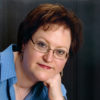Now here at the Zaręby Kośćielne (Zaromb in Yiddish) cemetery, I select some small rocks from the ground and dump them into my backpack.
My duty done, I say, “I’d like to see the forest.”
We return to Jasio’s house and squish into Ania’s Peugeot. We ride along 11 Listopada Street, named to commemorate the day of Polish independence in 1918 and then another unnamed street to the train station. We pass cows near the road and on the road. We pass pig pens, which I’m sure would have delighted my Orthodox ancestors. We pass fields and fruit trees. We stop momentarily at a stone and brick building, set far in from the road, with broken windows.
“This was the electric mill,” Jasio says. “Owned by the Jew, Grynspan. He hid during the war and survived.” The mill operated around the clock and made a constant ticking sound.
We reach the railroad tracks. To the left is the train station. To the right is Leshner Forest, woods full of pine trees that gave rise to the village’s tar business and where the Jews strolled on Shabbos afternoons with picnic lunches to talk of their futures. “It was a meeting place for young people,” Jasio says.
“How long would it have taken anyone from the village to get here?” I ask.
Jasio says, “Half an hour. It’s three kilometers.” A little less than two miles.
I step around a sizable trench, dug by the Soviets to stake out the railroad tracks overtaken by the Nazis. Visions of men in army uniforms with machine guns or bayonets focused on the tracks come to my mind. The ground is a soft bed of pine needles. I pick up a few pine cones to bring home. The trees blanket the sky and it is delightfully cool here. I hear echoes in the breeze. I doubt if any of the landscape has changed since the ‘40s, the satellite dishes of Warsaw vacationers notwithstanding.
The train station looks like an Old West movie set. I expect a tumbleweed to roll by at any moment. Weeds and daisies overrun the tiled walkway. I know the train station was built in the early ‘20s, after my grandfather left. He would have had to walk to Malkin and take the train from there to Warsaw.
I continue to take notes and draw maps in my journal. The day grows late, and Ania and I still have to return Ryszard to Ostrów Mazowiecka and then head back to Warsaw. I am completely drained. I still can’t quite believe I have been in my grandparents’ towns.
I can’t wait to tell my uncle about it. But I can’t tell my mother. And I still haven’t seen the Brok. How could a river just dry up like that? We drive over a bridge and I spot water.
“Stop the car,” I demand. “This is the Brok I was looking for.”
Not quite a stream, but more like a cesspool, there it is. Poplar and linden trees cast their shadows on a grassy knoll that slopes down to the water. Frogs jump from lily pad to lily pad without disturbing the floating algae. I stand on the bridge and take photos, wondering if my grandfather ever stood here and watched. An online photo of a town where the Brok still flowed looked incredibly beautiful. I try to picture Zaromb with this body of water surrounding it. It must have been something. But it also feels right that it’s gone from this place.
We drive through two more streets we haven’t seen before. It looks like Shanty Town. I nearly kiss the ground and thank God that my grandfather left. I want to remember him. I want to remember all the Jews of Zaromb. If I had the money, I would like to buy Zaromb and erect a monument to the town’s Jews. I do not have the same feeling of loss in Zaromb that I did in Ostrova.
“It’s because the Jews were not killed in the village itself,” Ania says. “They were taken eight kilometers away to Sembor and executed.”
Ryszard gives the signal it’s time to leave. I take one last look around. I want to imagine my grandfather and his brothers cutting through the alleys and going to cheder for hours on end, following the traditions of so many generations before. He died in Brooklyn, but I know he’s here. My mother died in New Jersey, but I know she’s here, too. She is a butterfly flitting over that grassy knoll, protected by lepidopteran ancestors, liberated from her chrysalis of suffering.
 Barbara Krasner holds an MFA from the Vermont College of Fine Arts and teaches creative writing in New Jersey. Her work has appeared or is forthcoming in Michigan Quarterly Review, Nimrod, Paterson Literary Review, Whale Road Review, Minerva Rising, and other journals.
Barbara Krasner holds an MFA from the Vermont College of Fine Arts and teaches creative writing in New Jersey. Her work has appeared or is forthcoming in Michigan Quarterly Review, Nimrod, Paterson Literary Review, Whale Road Review, Minerva Rising, and other journals.